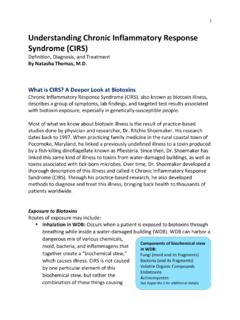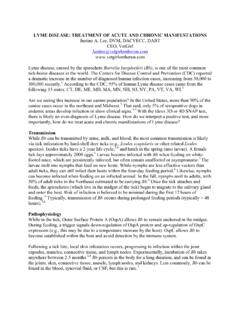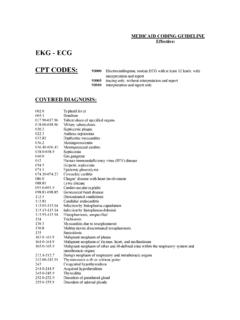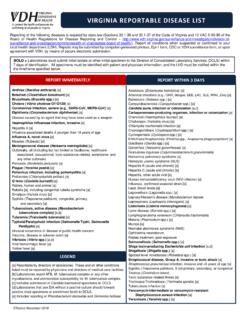Transcription of Peripheral Neuropathy: Differential Diagnosis and Management
1 Peripheral Neuropathy: Differential Diagnosis and Management HEND AZHARY, MD; MUHAMMAD U. FAROOQ, MD; MINAL BHANUSHALI, MD; ARSHAD MAJID, MD;. and MOUNZER Y. KASSAB, MD, Michigan State University College of Human Medicine, East Lansing, Michigan Peripheral neuropathy has a variety of systemic, metabolic, and toxic causes. The most common treatable causes include diabetes mellitus, hypothyroidism, and nutritional deficiencies. The Diagnosis requires careful clinical assess- ment, judicious laboratory testing, and electrodiagnostic studies or nerve biopsy if the Diagnosis remains unclear. A. systematic approach begins with localization of the lesion to the Peripheral nerves, identification of the underlying etiology, and exclusion of potentially treatable causes.
2 Initial blood tests should include a complete blood count, com- prehensive metabolic profile, and measurement of erythrocyte sedimentation rate and fasting blood glucose, vita- min B12, and thyroid-stimulating hormone levels; specialized tests should be ordered if clinically indicated. Lumbar puncture and cerebrospinal fluid analysis may be helpful in the Diagnosis of Guillain-Barr syndrome and chronic inflammatory demyelinating neuropathy. Electrodiagnostic studies, including nerve conduction studies and electro- myography, can help in the differentiation of axonal versus demyelinating or mixed neuropathy. Treatment should address the underlying disease process, correct any nutritional deficiencies, and provide symptomatic treatment.
3 (Am Fam Physician. 2010;81(7):887-892. Copyright 2010 American Academy of Family Physicians.). T. he Peripheral nerves consist of Diagnosis bundles of long neuronal axons Peripheral neuropathy can be caused by a as they exit the central nervous variety of systemic diseases, toxic exposures, system (CNS). Some Peripheral medications, infections, and hereditary dis- nerves are wrapped in a myelin sheath gen- orders (Table 1). The most common treatable erated by Schwann cells, whereas others causes are diabetes, hypothyroidism, and are unmyelinated. Peripheral nerves serve nutritional deficiencies. different motor, sensory, and autonomic HISTORY AND PHYSICAL EXAMINATION.
4 Functions. The term Peripheral neuropa- thy is usually used to describe symmetric When a patient presents with symptoms of and universal damage to adjacent nerves. distal numbness, tingling and pain, or weak- The damage and clinical manifestations ness, the first step is to determine whether are usually located distally with a proximal the symptoms are the result of periph- progression. Several disorders can dam- eral neuropathy or of a lesion in the CNS, age Peripheral nerves and cause Peripheral and whether a single nerve root, multiple neuropathy; it is important to differentiate nerve roots, or a Peripheral nerve plexus actual neuropathy from other disorders that is involved.
5 CNS lesions may be associated can have a similar clinical presentation. with other features, such as speech difficulty, double vision, ataxia, cranial nerve involve- Epidemiology ment, or, in cases of myelopathy, impair- One study estimated that the prevalence of ment of bowel and bladder functions. Deep Peripheral neuropathy in the family medi- tendon reflexes are usually brisk, and mus- cine setting is 8 percent in persons 55 years cle tone is spastic. Lesions of the Peripheral and The prevalence in the general nerve roots are typically asymmetric, follow population may be as high as a dermatomal pattern of sensory symptoms, A community-based study estimated the and may have associated neck and low back prevalence of Peripheral neuropathy in pain.
6 Lesions of the plexus are asymmetric patients with type 2 diabetes mellitus to be with sensorimotor involvement of multiple nerves in one extremity. April 1, 2010 Volume 81, Number 7 American Family Physician 887. Peripheral Neuropathy SORT: KEY RECOMMENDATIONS FOR PRACTICE. Evidence Clinical recommendation rating References Initial evaluation of a patient with Peripheral neuropathy C 5. A 128-Hz tuning fork should be used to should include a complete blood count, comprehen- test the vibratory sensations in extremi- sive metabolic profile, and measurement of erythro- ties. Loss of sensation (including vibra- cyte sedimentation rate and fasting blood glucose, tion, proprioception, temperature, and vitamin B12, and thyroid-stimulating hormone levels.)
7 Pinprick sensations) in distal extremities Electrodiagnostic studies are recommended if C 4, 5. symptoms persist and if the Diagnosis remains suggests Peripheral neuropathy, as does unclear after initial diagnostic testing and a careful a distal-to-proximal gradient of reflex history and physical examination. elicitation. Options for symptomatic treatment of Peripheral B 13-18. Once the lesion has been localized neuropathy include antiseizure medications, tricyclic antidepressants, and topical medications. to Peripheral nerves, the next step is to find the etiology and exclude potentially A = consistent, good-quality patient-oriented evidence; B = inconsistent or limited- quality patient-oriented evidence; C = consensus, disease -oriented evidence, usual treatable causes, such as acquired toxic, practice, expert opinion, or case series.
8 For information about the SORT evidence rating nutritional, inflammatory, or immune- system, go to mediated demyelinating disorders. The Table 1. Causes of Peripheral Neuropathy Type of Cause neuropathy Comments Laboratory tests Diseases Acquired immunodeficiency A Mainly sensory Human immunodeficiency virus test syndrome Carcinoma (paraneoplastic A Usually sensory Paraneoplastic panel (anti-Hu, anti-Yo, anti-Ri, syndrome) anti-Tr, anti-Ma, and anti-CV2 antibodies). chronic liver disease M Mainly demyelinating, especially in viral Hepatic transaminase, bilirubin, albumin, hepatitis and alkaline phosphatase levels Critical illness neuropathy A Usually acute or subacute No specific laboratory test Diabetes mellitus M chronic .
9 Axonal may predominate Fasting blood glucose level, glucose tolerance test, A1C level End-stage renal disease A Serum creatinine and blood urea nitrogen levels Hypothyroidism A Usually acute or subacute, but can be Thyroid-stimulating hormone level chronic Leprosy A Usually sensory Phenolic glycolipid-1 antibody, skin biopsy lyme disease A lyme titers Lymphoma M Mainly axonal CBC, imaging Monoclonal gammopathy Usually chronic Urine and serum protein electrophoresis Amyloidosis A Usually sensory with immunofixation Multiple myeloma M Axonal damage predominates after treatment Plasmacytoma D May have some axonal damage (osteosclerotic myeloma).
10 Monoclonal gammopathy of undetermined significance IgM D Most common; may have some axonal damage IgG or IgA M Demyelinating features often predominate Porphyria A Acute Porphyrin titers Syphilis A Rapid plasma reagin, VDRL, cerebrospinal fluid analysis Vitamin B6 deficiency A Sensory more than motor Vitamin B6 level Vitamin B12 deficiency A Peripheral neuropathy is intermixed with CBC; vitamin B12 and homocysteine levels;. upper motor neuron signs methylmalonic acid test continued Peripheral Neuropathy Table 1. Causes of Peripheral Neuropathy (continued). Type of Cause neuropathy Comments Laboratory tests Drugs*.
















